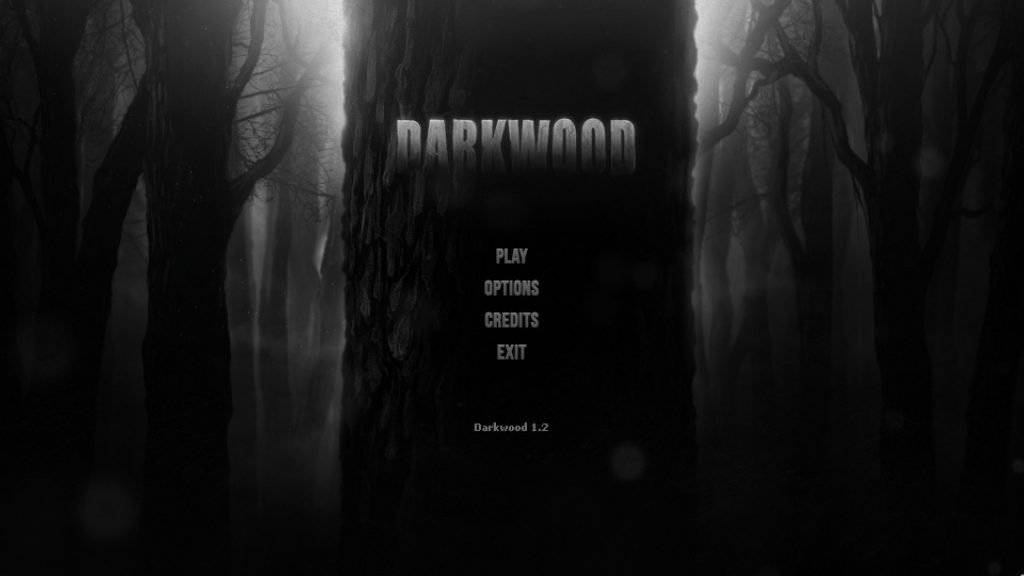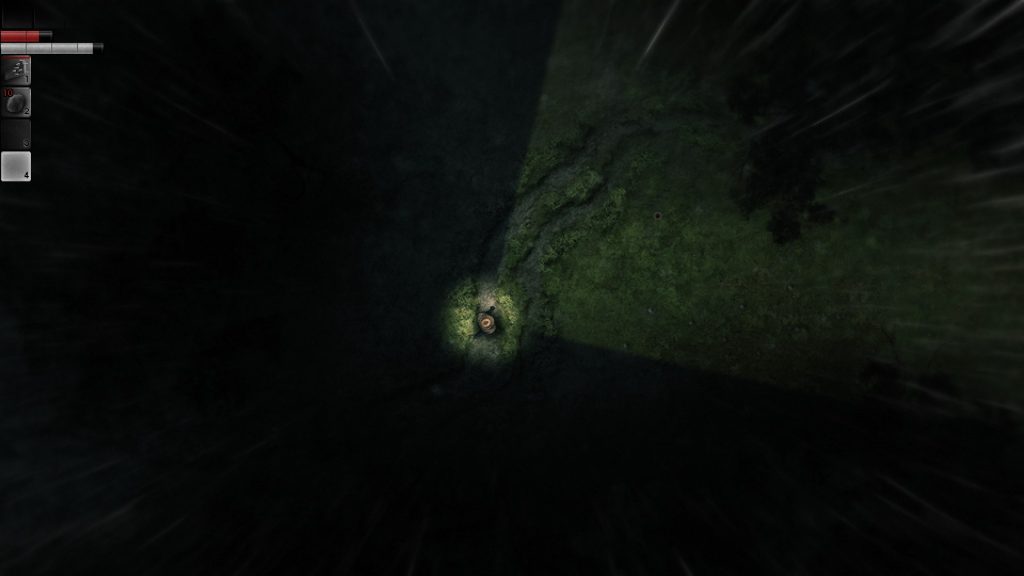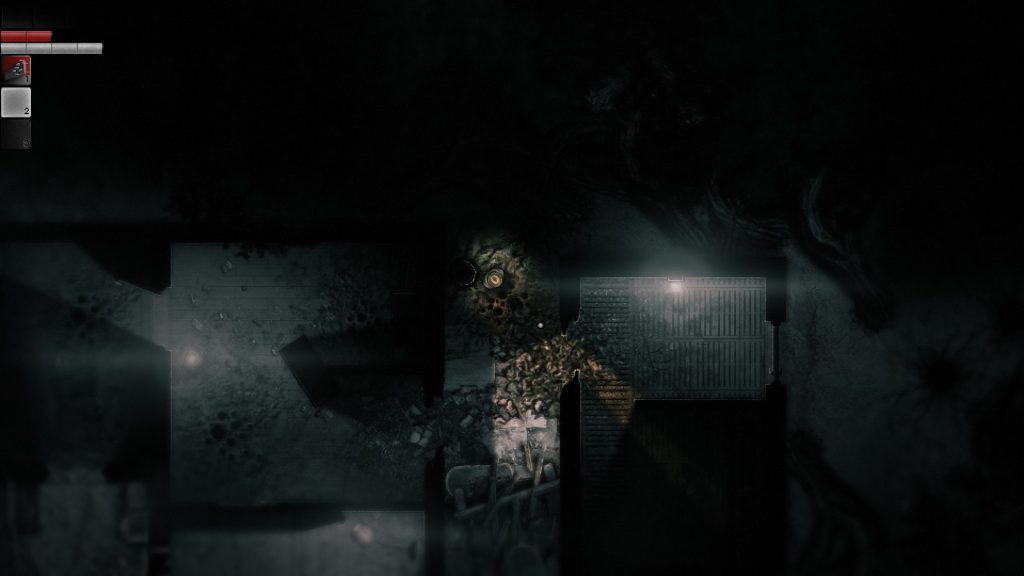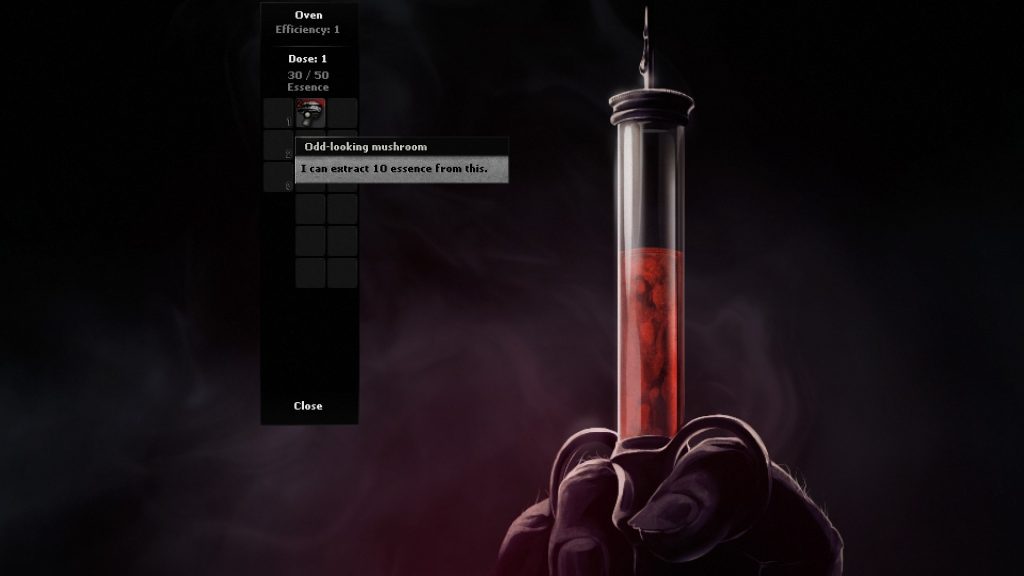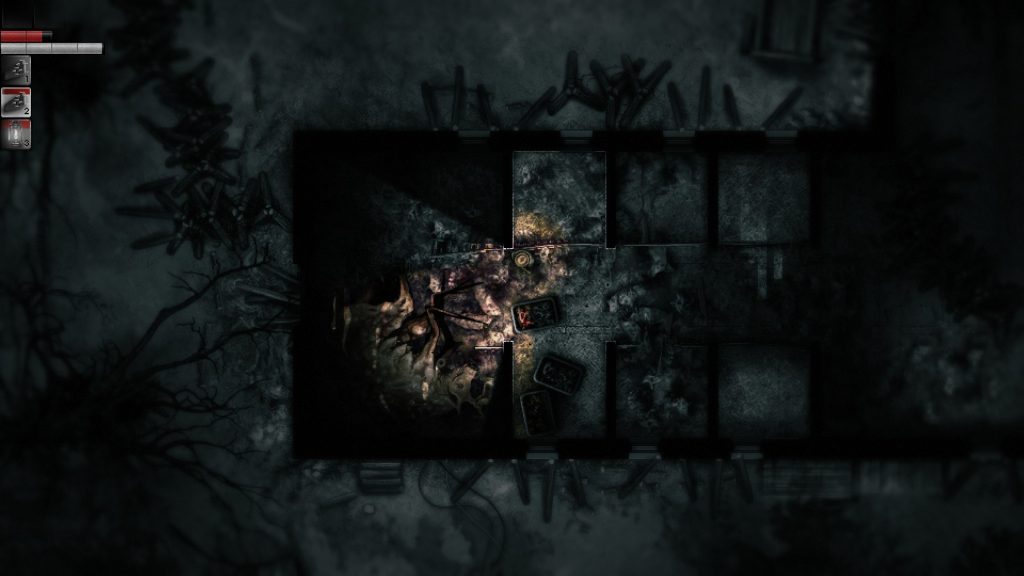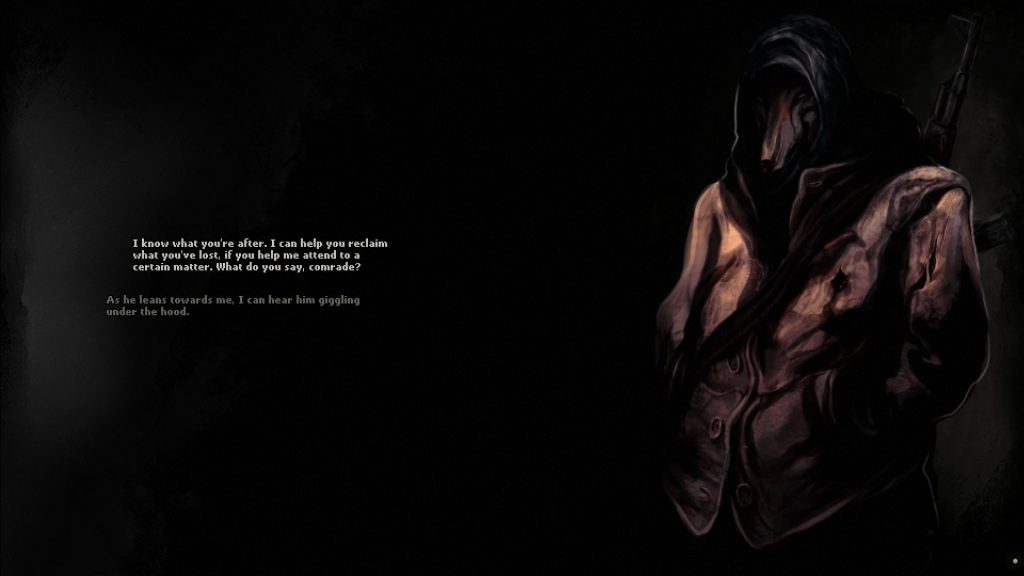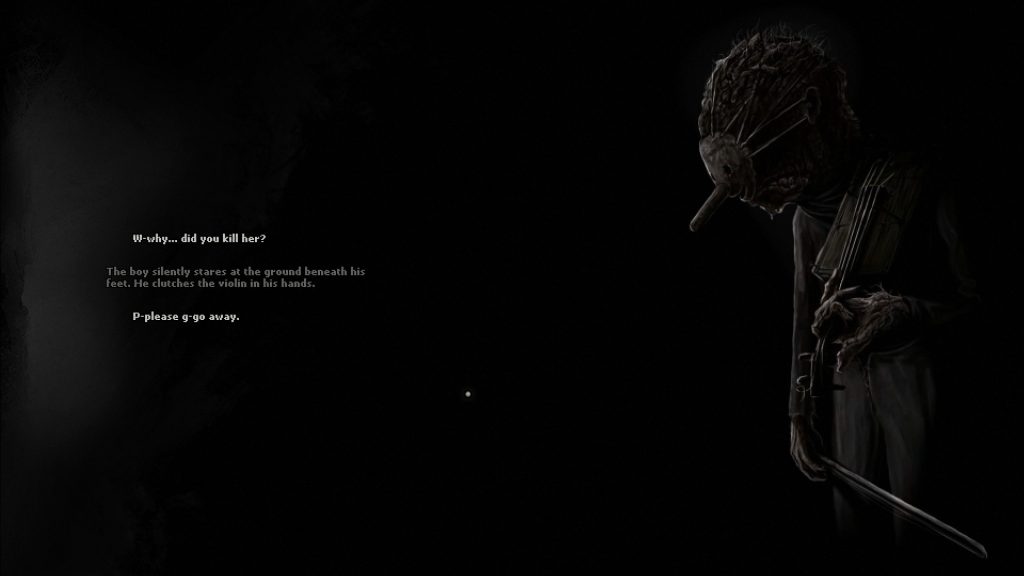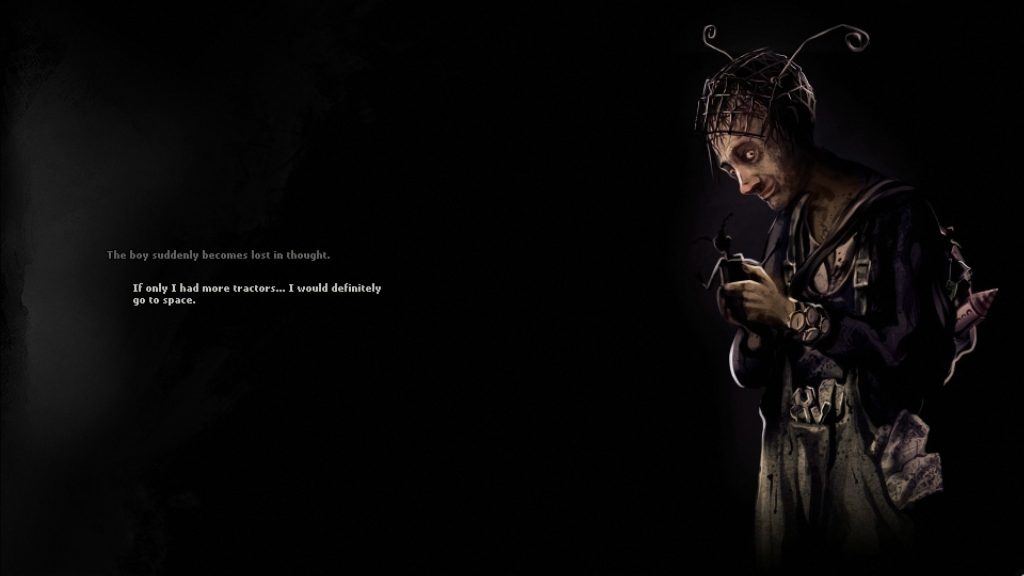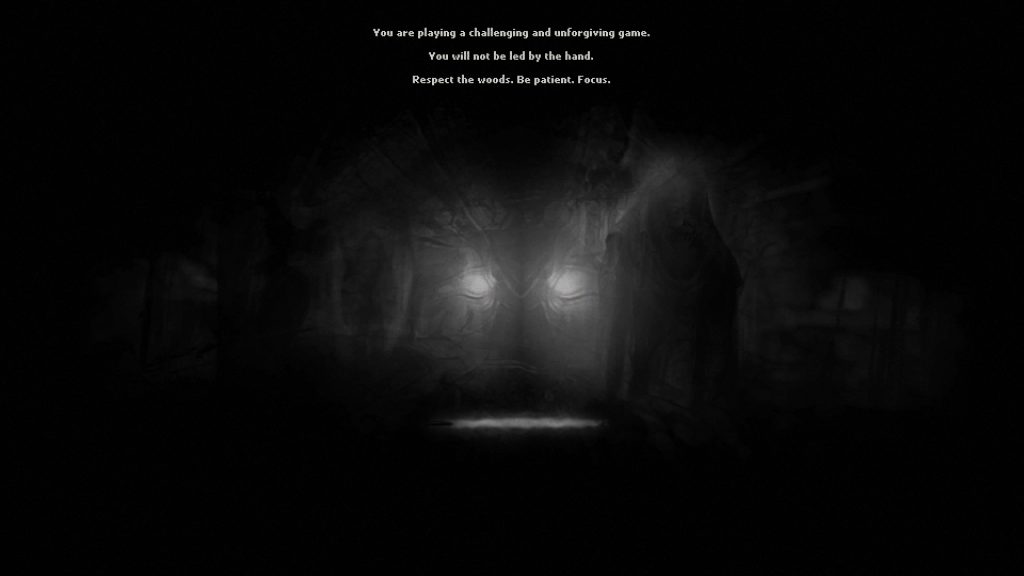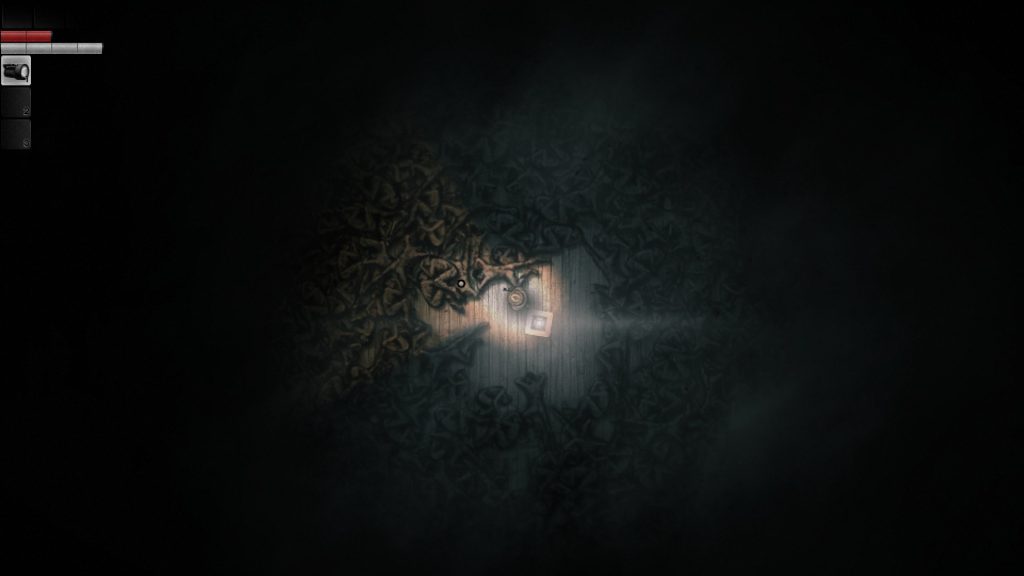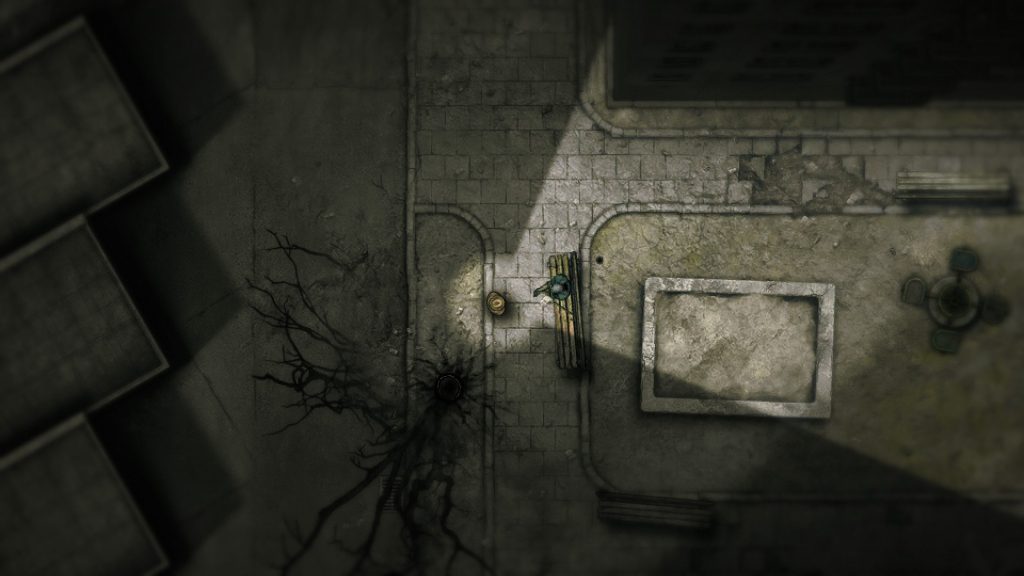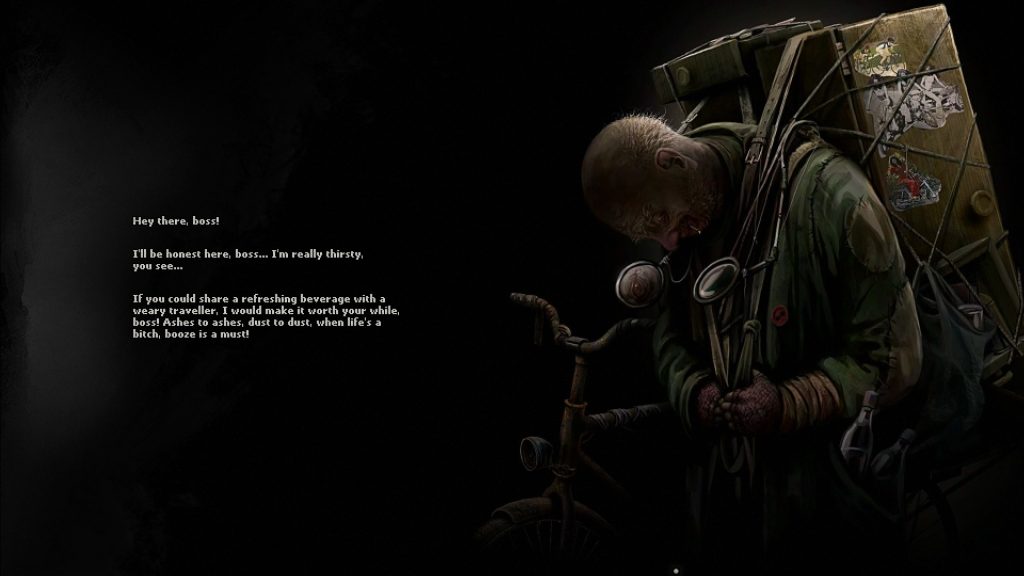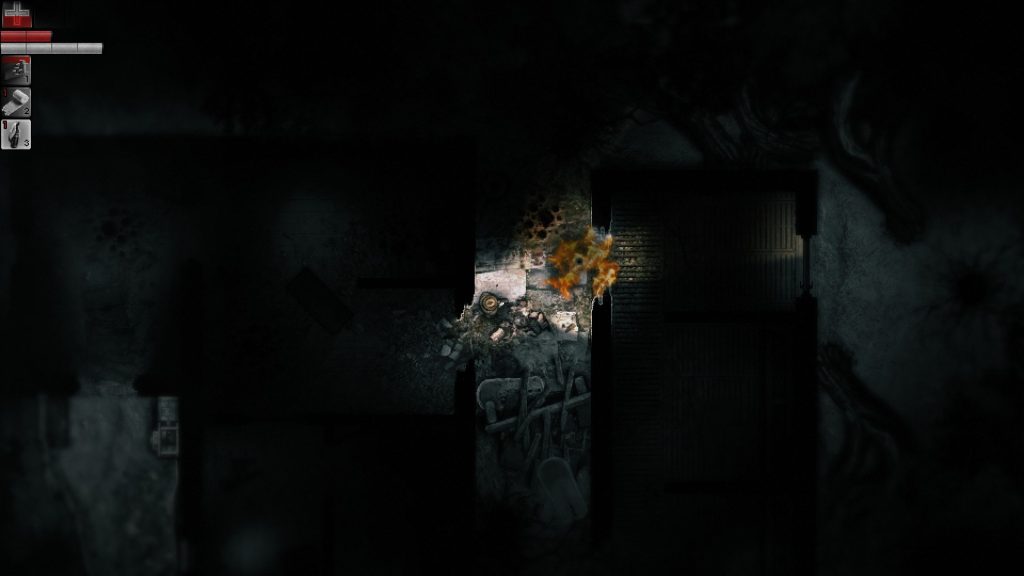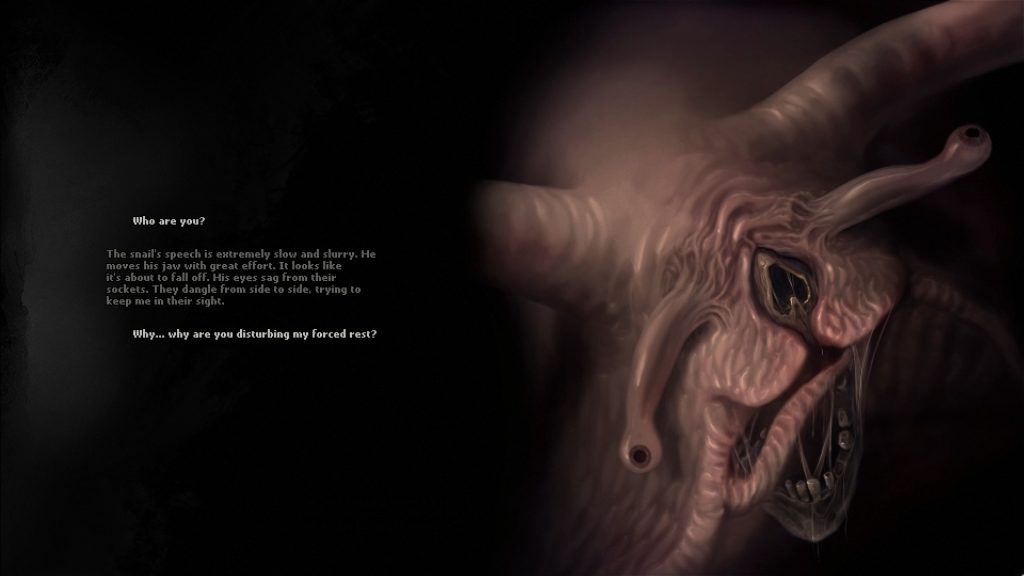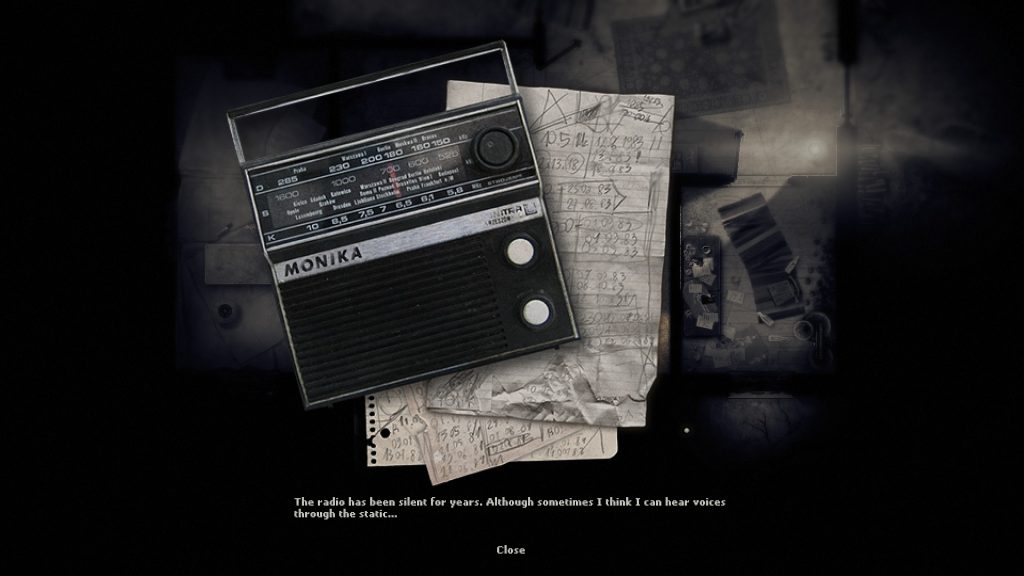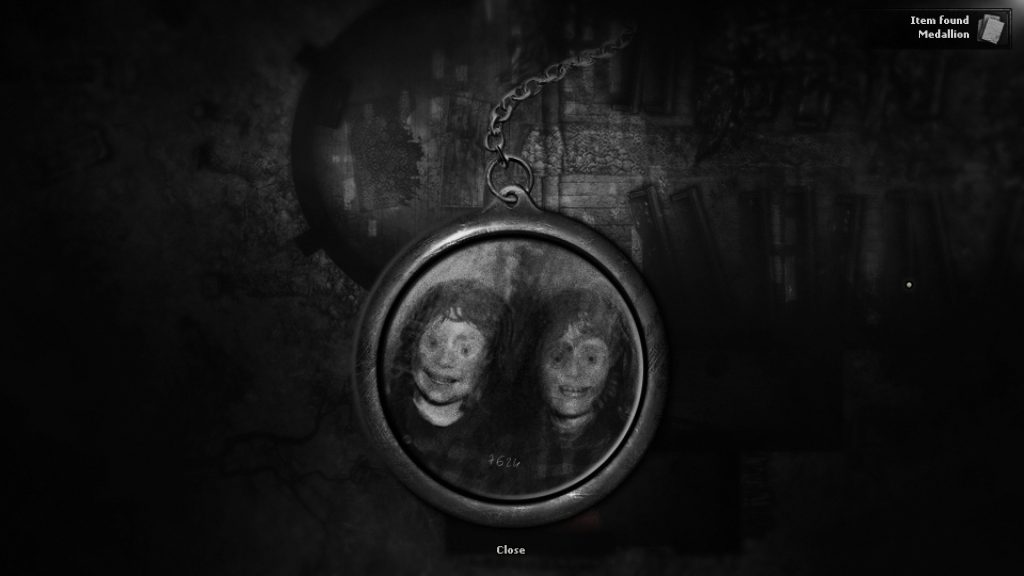It’s like if you took some of the good mood bits of Silent Hill 2 and smooshed it together with the survival aspects of the old Fallout games, the vision mechanics from Endless Sea, all in combination with some very simplified aspects of the survival craft genre. Oh, and Poland. That ends up being the perfect recipe for…
–Spoiler Alert–
To be up front, Darkwood is worth playing in a Tier 1 way. I didn’t even do a first-impression review, because I’ve done little else over the past couple weeks other than trod my way through its horrible forests and dank swamps. Let’s get you a backdrop–you wake up in a forest, kidnapped by some crazy doctor who won’t let you go. You break your way out and collapse, only to be rescued by a mute who talks by writing in charcoal. Eventually, you’ll enter the game-proper, which consists of wandering around a randomly generated forest, scavenging scraps of things you need to survive and running away from packs of savage dogs.
Let’s get the randomly generated thing out of the way real quick, because I feel that gives the wrong impression. Randomly “jumbled” may be a better way of putting it, since you’re guaranteed all that all the same pieces of the world will be in your game with each playthrough–it’s just their location and orientation that can be completely random (and trust me, that’s still enough to lose orientation during consequent playthroughs).
Anyway, as you start to piece things together plot-wise, you’ll gather that everything was fine in… wherever you are… until suddenly the forest appeared. Actually, it might not be quite “suddenly,” I suppose. Depending on which characters you talk to (and trust) some describe the forest as growing over time. Others describe crazy savages being the cause (or a symbiotic by-product?) of the forest. Oh, and I think the main character is a tree. Er–let’s wait on that.
So this forest has everyone trapped–people have tried to hack and saw their way through with no success. Either the forest grows back too quickly, the forest is too thick to even try, or the forest traps the place they live slowly, bit-by bit, until they become a part of it. Honestly, for a top-down game where you don’t exactly get a detailed picture of every little gruesome thing, the narrative does a great job of making everything pristinely creepy and depressing. It’s great, because the mood is potent at every location.
There are tons of “main” characters for the kind of game that it is (12~15 if I remember correctly). I say main because they’re the ones with lightly animated pictures (full body)–there are plenty of “minor” characters with speaking roles that are nameless. At first I didn’t give the game enough credit, since when I found the talking wolf that offered to trade with me, I thought, “Well of course there’s a talking wolf, because the game mechanically needs a character I can trade with.” I expected him to simply be the token shop-character. In truth, you trade with a handful of characters, and the wolf (while probably one of the first NPCs you’ll encounter) is by no means a packaged product that you are forced to consume in order to proceed with the game. In fact, after he killed Pirotek (whom I had a certain fondness for), I took a shotgun to his head, and I did just fine without him through the rest of the game.
I should briefly touch on the trading–there is no money, but instead a reputation system. It feels really good, both mechanically and thematically (why would there be a currency after all, in a forest with no economy?). Giving items to a character gains you reputation with them, which in turn allows you to take items from them. I do say “take” purposefully, since some characters (depending on how you’ve interacted with them) will simply let you take a part of their stock if they like you enough. Or if they’ve lost their mind. They don’t seem to care too much then.
I wish I could detail each adventure I had within the game, but to give a brief mention of the highlights, I danced with a ghostly bride that grew two heads and tried to eat me, I electrocuted a massive mutant sow, I helped a boy build a rocket out of a tractor, I shot a wolf-man in the head (as mentioned earlier), found the remains of a corrupted religion, dreamed a lot of weird sh!t, injected myself with some 50 distilled mushrooms (and another 50 units of the liquefied remains of enemies), played Pac-Man with horrible creatures at night in a large house, helped a snail, and burned a tree made out of people. I mean, it was a good ride.
The ending…? The ending was… well, it was soft. It was good, but it was soft. It didn’t hit you with some brilliant piece of plot that tied all the game’s events together. It didn’t give that epic ending causing you to re-analyze the entire game. It was… okay. I think for what Darkwood was, it was the best ending you could ask for, without the game going on another 40 hours (which it felt like it could have). I’ll explain the ending in just a second, but we actually need to go over the complaints first.
For starters, the game threatens on every loading screen:
“You are playing a challenging and unforgiving game.
You will not be led by the hand.
Respect the woods. Be patient. Focus.”
This really couldn’t be further from the truth. For starters, the game starts out with a tutorial. It meticulously walks you through, step-by-step how to play the game. I mean, it’s a good tutorial, it works really well in the narrative, but you’re still being “led by the hand” throughout its entirety. Secondly, “You are playing a challenging game,” is a little insulting to… actually challenging games. You have infinite lives. When you die, you drop half of the items in your pack (not your hotbar). Items never despawn–ever. Each day you wake up and a mute gives you free stuff. If you are completely green to the survival genre, then maybe, maybe this one will give you trouble but I was absolutely swimming in gear throughout every turn of the game. Don’t get me wrong–it was still a ton of fun–but I feel that it’s bold statement on every transition screen is a bit much.
Likewise, the game is… two chapters long. And I do mean chapters–after all, that’s what the game calls them. This does not mean the game is short at all, but it does make its pacing feel… weird. For instance, in the first chapter, the forest is segmented into three sections, each with a hideout that you can bunker down in. In the early parts of the game (and each time you enter a new part of the forest), this means that you’ll be desperately striking out hard into new territory, frantically searching for your bearings along with the next safe house. Then, when you find it, you’ll need to orient yourself to its layout, barricade the weakspots and set traps up at the ingresses that you can’t hole up. Eventually, you’ll start traveling in circles as you move through these three parts, visiting your old hideouts as if you are some punchable celebrity with a mansion in three states. It actually felt really good–even nostalgic to find myself caught out at night, with the need to run back to the original hideout and spend another night in there, provisioned by the few important supplies I had left behind for just such a scenario.
Then you move onto Chapter 2 which… just feels like a different game entirely. You only have 1 base, you’re in a swamp (which drastically changes how you need to think about traveling) and instead of the gameplay being cyclical, it becomes more sling-shotty. You rubber band out from the base in the morning, desperate to find the next interesting plot pieces, and instead of traveling onward to the next place you stay at night, you simply have to just turn around and go back. It’s not quite as fun.
Lastly, the game’s simplicity is wonderful, but sort of its downfall at the end. I think that (had the developers the time, money and resolve) the game could have gone on for another 2, 3 or 4 chapters. What was there was really good (I played the game for ~40 hours which should indicate that it’s still got a lot of content), and it didn’t feel unfinished or rushed at the end… just sort of awkward. Because of the simplicity, you were still having to overcome obstacles that you had been fighting against since the beginning of the game. It felt a bit annoying, since you had already proven time and time again that you were better than these challenges. Usually, I don’t like a game that let’s you upgrade past each obstacle brainlessly, but I think Darkwood would have benefited a little from it. It would have allowed the player to move a bit faster and so perhaps the pacing would have allowed for a couple more chapters. As it stands, I was exhausted by the end, and ready to be done, having mastered the simple (but effective) combat and survival mechanics.
The game maintains this constant theme of “The Road Home,” and symbolically that is the end of the game. You finally locate the road, go back to your apartment and go to sleep. Was any of it real? Is the hero still in the forest? Was it all a dream? And so on and so on. That’s one of Darkwood’s greatest strengths, and greatest weaknesses. It’s largely up for the player to decide what actually happened, or what any of the game actually meant. This is why personally, I think the main character is a tree. Many of the characters say that everything was fine until “you came here,” you constantly hear the call of some woman who seems to be the heart of the forest, your character isn’t just a silent protagonist, he’s literally mute–I choose to believe that the main character is a tree come to life from the evil forest. He gained sentience, created a personality based on what he thought a human might have, fabricated memories of a past life and broke free of the forest’s sentience. There’s… not a lot of data to back this theory up… but there’s not a ton of data to back any theory up, and this one makes sense to me as much as any other.
I don’t think it’s actually important–I think the true takeaway from the end of the game regardless of how you interpret the game’s actual events, is that it explores how various people look at life. Since you can’t talk, you do a lot of listening in the game–mainly communicating with others by showing them things. Nearly every character in the game can be shown a picture of a road titled “The Road Home,” and each character has their own interpretation of what it means, and what you are trying to tell them. It’s a nice way to reveal the inner-workings and psyche of each character, as they betray themselves by assuming what you meant when you show it to them. The forest could simply be a metaphor for life, and the way each character survives, another metaphor for the different kinds of people we meet each day. Or it could just be a literal wolf-man. I dunno.
I will definitely be coming back to this one, and probably trying a “Nightmare Mode” run (death = save file deletion) at some point. The game doesn’t have a linear plot, and as far as I can tell, there are multiple ways to “end” the plot of any character (for starters I’m pretty sure you can kill anyone). I don’t think Darkwood revolutionized the Horror genre for me, but it feels like a very good indie staple to it. Link below if you feel like trying it; I would recommend this one even to people who don’t like horror games, since it’s much more narrative focused and much less jump-scare/gore-focused than the typical game from the genre.
